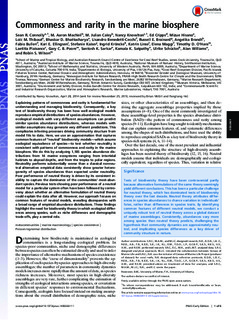| dc.contributor.author | Connolly, Sean R. | |
| dc.contributor.author | MacNeil, M. Aaron | |
| dc.contributor.author | Caley, M. Julian | |
| dc.contributor.author | Knowlton, Nancy | |
| dc.contributor.author | Cripps, Ed | |
| dc.contributor.author | Hisano, Mizue | |
| dc.contributor.author | Thibaut, Loïc M. | |
| dc.contributor.author | Bhattacharya, Bhaskar D. | |
| dc.contributor.author | Benedetti-Cecchif, Lisandro | |
| dc.contributor.author | Brainard, Russell E. | |
| dc.contributor.author | Brandt, Angelika | |
| dc.contributor.author | Bulleri, Fabio | |
| dc.contributor.author | Ellingsen, Kari Elsa | |
| dc.contributor.author | Kaiser, Stefanie | |
| dc.contributor.author | Kröncke, Ingrid | |
| dc.contributor.author | Linse, Katrin | |
| dc.contributor.author | Maggi, Elena | |
| dc.contributor.author | O'Hara, Timothy D. | |
| dc.contributor.author | Plaisance, Laetitia | |
| dc.contributor.author | Poore, Gary C.B. | |
| dc.contributor.author | Sarkar, Santosh K. | |
| dc.contributor.author | Sathpaty, Kamala K. | |
| dc.contributor.author | Schückel, Ulrike | |
| dc.contributor.author | Williams, Alan | |
| dc.contributor.author | Wilson, Robin S. | |
| dc.date.accessioned | 2014-06-03T11:49:23Z | |
| dc.date.accessioned | 2016-07-14T13:01:31Z | |
| dc.date.available | 2014-06-03T11:49:23Z | |
| dc.date.available | 2016-07-14T13:01:31Z | |
| dc.date.issued | 2014 | |
| dc.identifier.citation | Proceedings of the National Academy of Science of the United States of America 2014 | nb_NO |
| dc.identifier.issn | 0027-8424 | |
| dc.identifier.uri | http://hdl.handle.net/11250/2396546 | |
| dc.description.abstract | Contributed by Nancy Knowlton, April 28, 2014 (sent for review November 25, 2013; reviewed by Brian McGill and Fangliang He)
Explaining patterns of commonness and rarity is fundamental for
understanding and managing biodiversity. Consequently, a key
test of biodiversity theory has been how well ecological models
reproduce empirical distributions of species abundances. However,
ecological models with very different assumptions can predict
similar species abundance distributions, whereas models with
similar assumptions may generate very different predictions. This
complicates inferring processes driving community structure from
model fits to data. Here, we use an approximation that captures
common features of “neutral” biodiversity models—which assume
ecological equivalence of species—to test whether neutrality is
consistent with patterns of commonness and rarity in the marine
biosphere. We do this by analyzing 1,185 species abundance distributions
from 14 marine ecosystems ranging from intertidal
habitats to abyssal depths, and from the tropics to polar regions.
Neutrality performs substantially worse than a classical nonneutral
alternative: empirical data consistently show greater heterogeneity
of species abundances than expected under neutrality.
Poor performance of neutral theory is driven by its consistent inability
to capture the dominance of the communities’ most-abundant
species. Previous tests showing poor performance of a neutral
model for a particular system often have been followed by controversy
about whether an alternative formulation of neutral theory
could explain the data after all. However, our approach focuses on
common features of neutral models, revealing discrepancies with
a broad range of empirical abundance distributions. These findings
highlight the need for biodiversity theory in which ecological differences
among species, such as niche differences and demographic
trade-offs, play a central role.
metacommunities | marine macroecology | species coexistence |
Poisson-lognormal distribution | nb_NO |
| dc.language.iso | eng | nb_NO |
| dc.rights | Navngivelse-Ikkekommersiell-DelPåSammeVilkår 3.0 Norge | * |
| dc.rights | Navngivelse-Ikkekommersiell-DelPåSammeVilkår 3.0 Norge | * |
| dc.rights.uri | http://creativecommons.org/licenses/by-nc-sa/3.0/no/ | * |
| dc.subject | metacommunities | nb_NO |
| dc.subject | marine macroecology | nb_NO |
| dc.subject | species coexistence | nb_NO |
| dc.subject | Poisson-lognormal distribution | nb_NO |
| dc.title | Commonness and rarity in the marine biosphere | nb_NO |
| dc.type | Journal article | nb_NO |
| dc.type | Peer reviewed | nb_NO |
| dc.date.updated | 2014-06-03T11:49:24Z | |
| dc.source.pagenumber | 8524-8529 | nb_NO |
| dc.source.volume | 111 | nb_NO |
| dc.source.journal | Proceedings of the National Academy of Science of the United States of America | nb_NO |
| dc.source.issue | 23 | nb_NO |
| dc.identifier.doi | 10.1073/pnas.1406664111/-/DCSupplemental. | |
| dc.identifier.cristin | 1135944 | |

